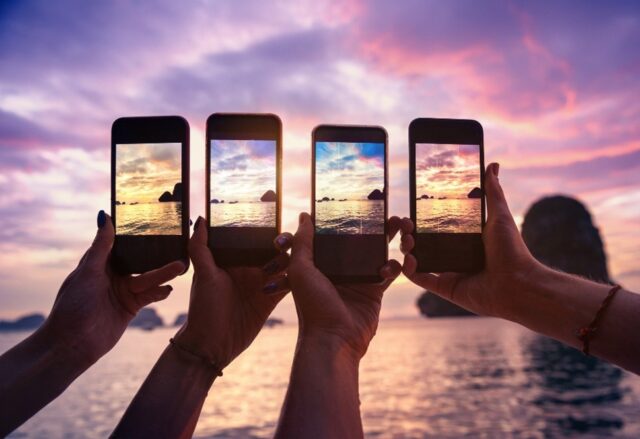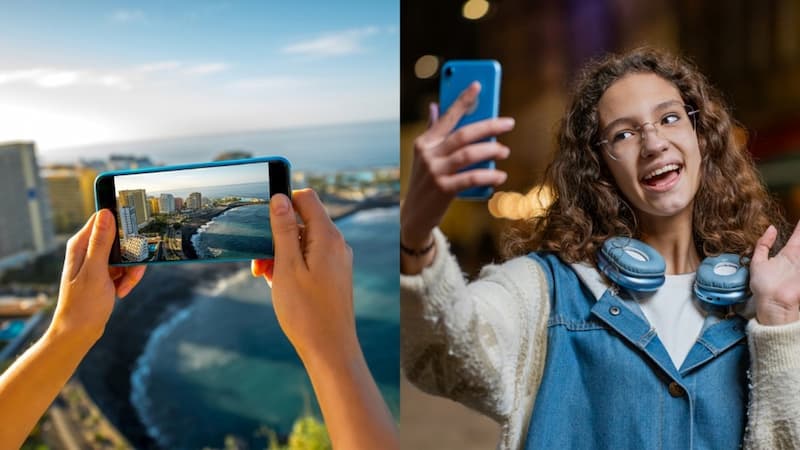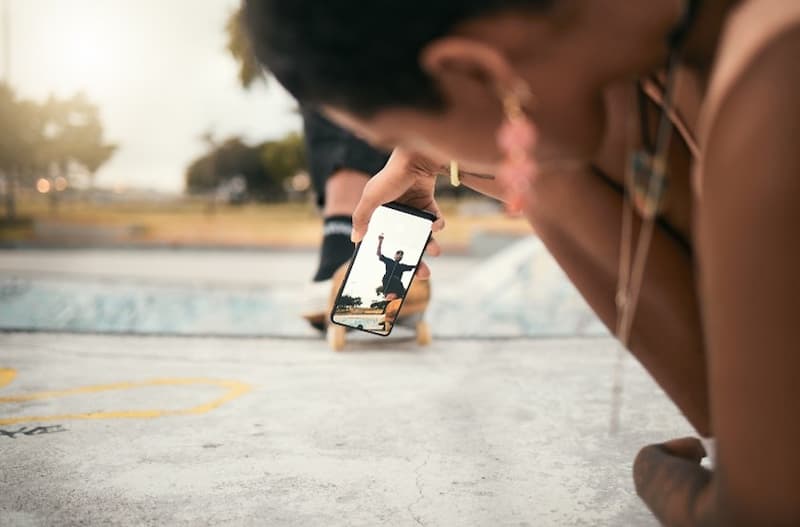Samsung Galaxy S22 Ultra Vs iPhone 13 Pro Max

We love taking pics with our phones, and I bet you do too. So you need to know about the amazing cameras on these two great smartphones from Samsung and Apple. You’ll leave basic selfies and low-quality photos behind with these cameras, but there’s one question: which one is the best for you?
Today’s blog will help you figure that out by comparing these two impressive phones and their features based largely on their built-in cameras and apps. And if, by the end, you think, “It’s time to sell my phone and upgrade to one of these!”, we’ve got you covered with our popular online trade-in service.
A peek at camera specs
When it comes to hardware, both the Galaxy S22 Ultra and iPhone 13 Pro Max are equipped with the highest quality components designed to deliver exceptional performance.
 The S22 Ultra’s impressive camera hardware
The S22 Ultra’s impressive camera hardware
The Galaxy S22 Ultra has the most impressive hardware in the S22 trio. Its 40-megapixel camera sensor on the front is four times the size of the S22+ and S22 standard, making it perfect for the highest detailed selfies.
On the rear, the rear wide-angle camera has double the megapixel sensor (108), a denser pixel size for more detailed photos and a 10x dual optical zoom and super-resolution zoom of 100x. With these improvements, you’ll see amazing results when taking holiday snaps, as you’ll have the image quality and density of a professional-grade DSLR manual camera and a convenient, deep zoom all in your pocket.
Some cameras will struggle with the extreme lighting of bright sunny locations or exciting nightlife, but from what we can see, the Samsung Galaxy S22 Ultra is well equipped to provide amazing photos at any time, in any weather and in any conditions. The Super HDR feature makes colours pop even in tricky lighting, while the Night Mode ensures your low-light shots are bright and clear. Plus, with the advanced AI-powered camera software, you can effortlessly take professional-looking portraits with beautifully blurred backgrounds.
 The iPhone 13’s adaptive camera hardware
The iPhone 13’s adaptive camera hardware
The iPhone 13 Pro Max continues Apple’s tradition of improving each generation’s camera for better photos and video. This model’s focus, however, is on improved focus, either in far or close shots, and adaptability to suit any conditions.
It has a wide camera with an impressive 12-megapixel sensor and a 2.8 aperture, capturing 49% more light than its predecessor. This means your photos will be brighter and more detailed, even in low-light conditions. The digital zoom capabilities of the iPhone are low; there is a sufficient 3x optical zoom on the telephoto lens, which brings you closer to the action without losing image quality.
What makes the iPhone 13 Pro Max stand out? It’s all about the incredible ultrawide camera that lets you get up close and personal—like, really close! Imagine capturing the delicate texture of a flower petal on your vacation or the intricate details of that stunning piece of jewellery you just received, all from just 2cm away! This phone’s macro photography skills are seriously next-level, ensuring you never miss a tiny detail. And with the iPhone’s automatic adaptability, you’ll always nail the perfect shot, no matter where you are. It’s like having a pro photographer in your pocket!
The AI edge: software enhancements
AI-powered automated phone software and apps are a huge part of smartphones nowadays, and these are no different. Each year, there are new and exciting trends in mobile photography, and this year’s features are absolutely AI-powered. The technology is being used in several ways, including improving photo and video footage. For example, the Samsung Galaxy S22 Ultra includes features like Scene Optimiser and Single Take mode, both driven by AI.
- Scene Optimiser adjusts settings based on the subject.
- Single Take captures multiple photos and videos with a single press, letting you choose the best shot.
The iPhone 13 Pro Max has an A15 Bionic chip to power various advanced AI photography features, such as:
- Smart HDR adjusts exposure and colour balance in real time to get the best contrast and look for your images.
- Deep Fusion enhances details and reduces noise, especially in medium to low light, and it makes sure your photos don’t look like they were taken in 2002!
- Photographic Styles is a feature that lets you customise the look of your photos without affecting skin tones; the AI element protects the skin tones.
Both devices offer sophisticated software solutions, but the iPhone’s approach tends to deliver a more polished and consistent output across different lighting conditions.
For example, TrueDepth is Apple’s name for a unique feature of the front camera, facial scanning. The TrueDepth system projects thousands of invisible tracking dots and uses LiDAR scanners to get infrared data on your face when taking front camera selfies; this is so the phone can process the data and automatically adjust settings like brightness and saturation to make sure you look your best all the time! It does this by not just seeing your face as a 2D image but as real-life 3D dimensions. As a result, it understands the scene better and can make intelligent improvements.
This tech is mainly for the accuracy of FaceID unlocks for the security system, but it’s also being used to automatically improve selfies and videos by adding stabilisation, cinematic modes and colour corrections that all make your images pop!

Comparing photography
In bright daylight, both smartphones shine, making it tough to pick a clear winner—but there are a couple of small differences worth noting. When it comes to capturing detail, Apple pulls ahead slightly. Its trio of lenses work together like a dream team, gathering all the data needed to create bright, crisp, and detailed images. Samsung, on the other hand, might not pack as much punch in daylight due to its dual-lens setup, but it makes up for it with fantastic image stabilization—perfect for capturing fast-moving action rather than those carefully staged shots.
But the real showdown happens after dark. The Galaxy S22 Ultra’s Night Mode is a powerhouse, brightening up your photos while keeping noise low, though it can sometimes get a little overenthusiastic with the colors. Meanwhile, the iPhone 13 Pro Max steps up with its Night Mode and Deep Fusion technology, delivering balanced, low-noise photos with spot-on colors. And thanks to the LiDAR scanner, the iPhone locks in on low-light shots with fast, precise focus, giving it a serious advantage when the lights go down.

Sure, the iPhone might not have the same zoom capabilities as the Galaxy S22 Ultra, but its TrueDepth and LiDAR scanner really amp up depth sensing, improving both focus and performance in low-light conditions.
Action shots and video compared
Are you an up-and-coming YouTuber? A Twitch streamer in the making? If so, pay attention closely as we delve into the video specs you’ll need to utilise to keep your audience engaged! The Galaxy S22 Ultra supports 8K video recording with ultra-high-resolution videos that capture every detail. Its built-in Super Steady mode ensures smooth footage even while moving, and Pro Video mode speaks for itself with its advanced controls for professional-grade video recording whilst being automated for those who want simplicity to enjoy. This is an excellent phone for IRL streamers and vloggers who want to capture their outstanding locations or action-packed lives.
The iPhone 13 Pro Max, on the other hand, offers ProRes video recording, which gives great quality and editing flexibility all in one handset. Also, Cinematic Mode adds a depth-of-field effect, focusing on the subject while blurring the background for a more cinematic look.
Both devices excel in different aspects of video recording, but it’s clear that the Galaxy S22 Ultra focuses on resolution and stabilisation, and the iPhone 13 Pro Max offers advanced colour grading and cinematic features. Both are valid choices, but which to choose depends on your lifestyle. We would say that the Galaxy suits fast-moving recording, pure recording in the moment, whereas the iPhone chooses to improve what you capture in comfort afterwards with its various post-production software apps.

User experience: camera app ease of use
We’ve talked about the quality of the photos and videos that these phones provide, but what are they like to use? User experience can make or break your enjoyment of a phone, so let’s take a look at how each phone’s camera app works to find which one is the best choice for you.
The Samsung Galaxy S22 Ultra’s camera app offers extensive customisation options, with a Pro Mode that allows manual adjustments of settings like ISO and shutter speed. This level of control is perfect for experienced photographers but might feel overwhelming for casual users. The app’s layout is generally intuitive, but navigating through its many features may require a bit of a learning curve.
In contrast, the iPhone 13 Pro Max’s camera app is all about simplicity and ease of use. Its clean and straightforward interface provides quick access to essential shooting modes. Features like Night Mode, Portrait Mode, and Cinematic Mode are easily accessible, making it easy for everyone to get what they want.
Which phone is the best for mobile photography?
While both the Samsung Galaxy S22 Ultra and iPhone 13 Pro Max offer exceptional camera capabilities, each has its unique strengths that should be considered when looking to buy one. Here’s our verdict:

The Samsung Galaxy S22 Ultra is perfect for capturing life on the go, with 8K video recording and Super Steady mode that ensures smooth, detailed footage even in motion. Its fast autofocus and quick shutter response make it ideal for action shots, while Pro Video mode offers advanced controls for those seeking professional-quality videos on the move.
The iPhone 13 Pro Max is tailored for studio-based photography, excelling in controlled environments where precision matters. ProRes video recording and Cinematic Mode offer high-quality, editable footage with dramatic depth. Photographic Styles and Dolby Vision HDR enhance your photos and videos, making them ideal for creators focused on planned, high-quality shoots.
Of course, there are other considerations to think about when choosing a smartphone, but when it comes to their photography capabilities, this should help you make the best choice for you. Find your inner smartphone photographer with one of these today, and replace your old phone by using either our Samsung trade-in or sell your iPhone 12 to us and get money back to get the photography smartphone you’ve always wanted.

